Photo by James D. Schwartz / The Urban Country
Left turns are one of the most dangerous manoeuvres to execute on a bicycle in North America. Of course, this doesn’t have to be the case. Many cities have engineered infrastructure to make left turns safe and comfortable for bicyclists.
But here in Toronto – and most other cities in North America – turning left legally is unsafe.
Here’s why: In order to make a legal left turn on a two-way street in Toronto, you must first merge from your normal riding position on the right side of the road to the left-most lane. This in itself can be dangerous and is unnecessary.
Next, you need to wait for oncoming traffic to clear before you can proceed with your turn. If you are fortunate enough to have a separate turning lane, then you will be immune from impeding traffic behind you.
However, in many cases in downtown Toronto, you will not have the luxury of a turning lane – so you will inevitably be unnecessarily holding up already-frustrated motorists.
Being someone who avoids unnecessarily dangerous situations, I rarely make legal left turns on busy streets in downtown Toronto for the reasons stated above. In a 2009 commute to work video I posted on blogTO.com, I was criticized by a commenter for doing a hook left turn using the pedestrian walkway.
In the absence of proper infrastructure for left hand turns, I recommend that bicyclists enter the pedestrian area to make a hook left turn (when it is safe to do so). This involves staying to the right, and pulling into the pedestrian crossing area, then waiting for the alternate light to turn green.
A hook left turn could easily be accommodated with a tiny bit of infrastructure. Here is a diagram of the safer hook left turn bike box – courtesy of Inscrutable Ted:
This infrastructure reduces unnecessary conflict between motorists and bicyclists because the bicyclist isn’t forced to hold up traffic while making a left turn.
Here is a video from our friend AlexWarrior that nicely demonstrates a hook left turn in Vancouver. Watch the video in the bottom left corner:
Instead of accommodating the hook left turn, the City of Toronto seems to think that traditional bike boxes are the solution for safe left turns.
A bike box is a painted area that allows bicyclists to gather at a traffic light in front of automobiles. This helps improve visibility and reduces the chances of cars right hooking bicyclists while turning right.
Here is how Toronto is proposing to accommodate left turns using bike boxes.
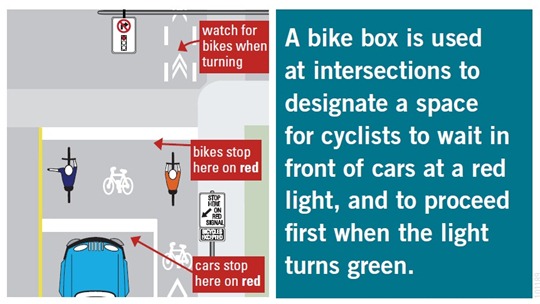
Courtesy of City of Toronto bike box postcard
One can imagine the hostility of the motorist in the blue car for having to wait for a bicyclist to turn left while he is trying to proceed straight. This is an avoidable and unnecessary conflict.
Here is a photo of a recently implemented bike box with a left turn area in Toronto:
Photo by James D. Schwartz / The Urban Country
Fortunately this left turn lane for bicycles includes a separate left-turn lane for automobiles, so a left-turning bicyclist wouldn’t be forced to hold up traffic to make her left turn.
However, these bike boxes are inadequate because the markings don’t make it obvious enough to motorists that they need to stop behind the first white line.
Here are two photos of a typical bike box in Portland, Oregon that take this into account:
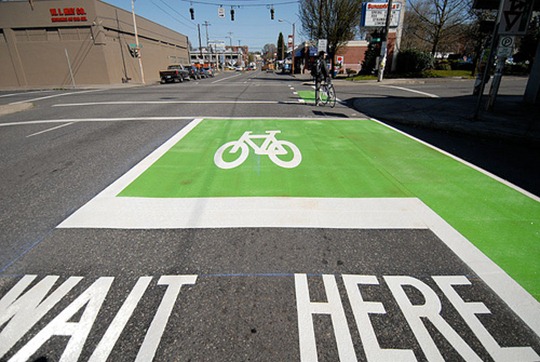
Photo courtesy of itdp / Flickr
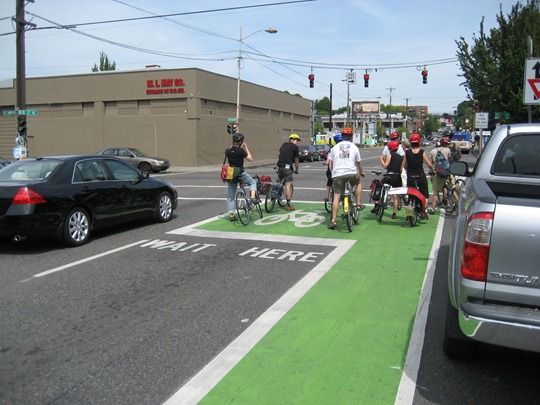
Photo courtesy of Rich & Cheryl / Flickr
Toronto’s implementation seem to cause confusion for motorists. While taking these photos, it didn’t take long for me to witness several motorists ignore the bike box markings:
Photo by James D. Schwartz / The Urban Country
Bike boxes aside, other cities support left turns for bicycles in different ways.
The Chinese approach is fairly simple and doesn’t hold up motorists: Bicyclists have a left turn signal that allows them to turn left from their bike lane to the other bike lane on the perpendicular road.
This bicycle turn signal works in conjunction with the automobile left turn signal so that bicycles and cars can both turn at the same time – each staying within their own painted lines while making their respective turns.
This approach eliminates the need for bicyclists to merge into traffic, but one must still be cautious while making a turn because motorists are turning at the same time. The Chinese aren’t known for staying within the painted lines.
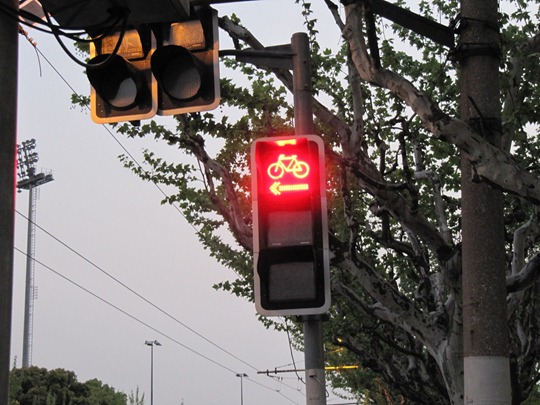
The ideal implementation for left turns of course comes from the Dutch. Some Dutch cities have physical separation between motorists and bicyclists even for left turns to avoid any possible conflict between the two. Here is a typical Netherlands junction with separate signals for bicyclists:
Photo courtesy of markenlei’s Youtube video on safe junctions
Bicyclists are able to proceed and immediately make a protected two-phase hook left turn while motorists wait. This wouldn’t be a hot seller in North America’s car-centric culture, but perhaps this will change as more people start using bicycles for transportation.
This type of implementation also requires a significant amount of space to implement, so it wouldn’t work on all streets. In dense cities where space is limited, a hook left turn implementation would suffice for safe left turns, and would be substantially better than our current method of forcing bicyclists to merge into traffic to make a left turn.
James D. Schwartz is the editor of The Urban Country. You can contact James at james.schwartz@theurbancountry.com.
Related Articles:
- Futile Bicycle Signals (Sept 2010)
- Motorists Against Bicycle Infrastructure (Oct 2010)
- Handicap Bike Parking (May 2010)
- Bike Lanes: A Motorist Invention? (Feb 2010)


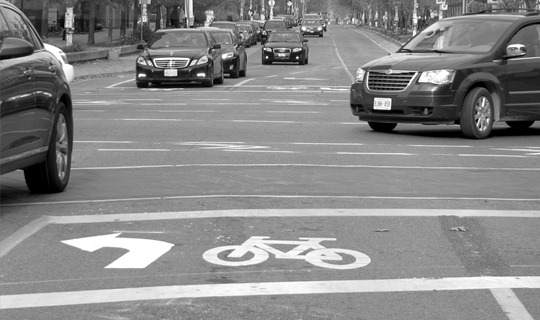
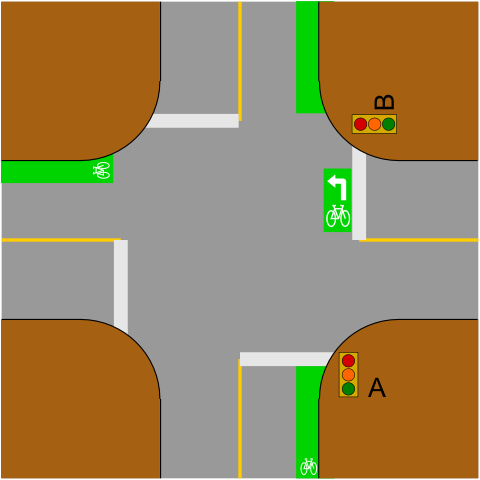
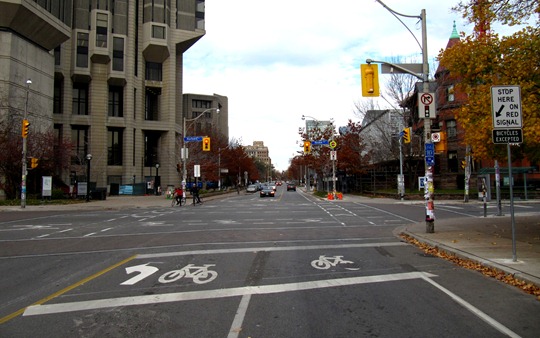
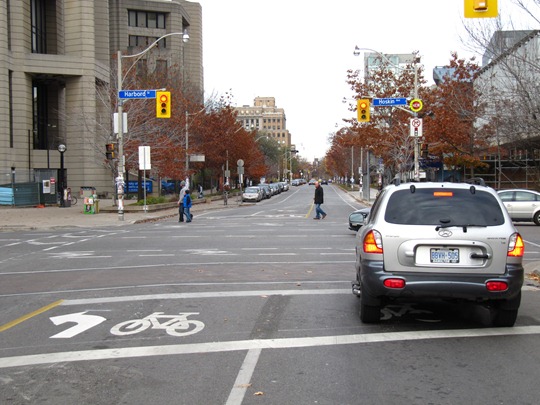

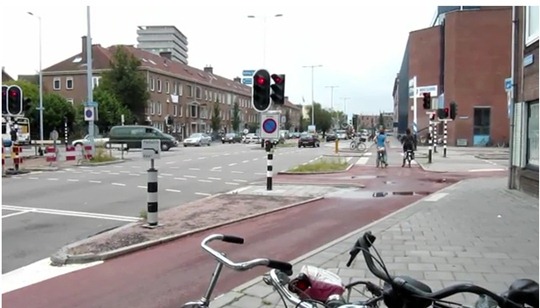
A left turn on my route home from work has a piece of infrastructure set up for doing a two-step left turn like you describe (look in the lower-left picture-in-picture from this video):
http://www.youtube.com/watch?v=XfEpDT8LdNo
I find the regular bike boxes help too, although as you mention, having vehicles stopped in them makes them a bit harder to use! :
http://www.youtube.com/watch?v=Xpc_0ijzpnI
I’ve always heard of those safe left turns referred to as Copenhagen Lefts. They are the safest way bar none.
Bike boxes on left turns give me the willies. Wait until a motorist runs the yellow on the cross street and decides to cut the corner. It happens all the time.
Painting them fluorescent green would help though.
There are 2 intersections where hook turns or “indirect left turns” are used in Toronto (that I know of). The first at Sherbourne and Bloor is in dire disrepair and only a sign remains even though the crosswalk was set back to accommodate waiting cyclists. The second is at Dupont/Annette/Dundas West and the designated waiting area is actually in the bike lane, causing conflicts with cyclists proceeding straight to Dundas from Dupont. Here’s more: http://bikingtoronto.com/duncan/handling-street-car-tracks-and-difficult-intersections-with-indirect-left-turns/
I didn’t see anything wrong with how you turned on the video.
I think that is how many cyclists make a left.
I’ll go into a left turning lane ONLY if it’s relatively quiet on the roads and there is a designated left turning lane.
Any time I have made a left while there was considerable traffic on the road I haven’t run into an issue.
Good communication with motorists helps out (ie signalling your left turn).
I really can’t say much for bike boxes having never encountered one.
Alex, thanks for the video – it demonstrates the hook (or indirect, or Copenhagen) left turn nicely. I embedded the video in the article.
Duncan, I had forgotten about the Sherbourne hook left turn. I’ve ridden past it several times, but like most people, I rarely have a reason to go down Sherbourne street 😉 I wasn’t aware of the Annette/Dupont/Dundas indirect left turn – but it doesn’t sound like it’s engineered very well anyway. Thanks for the link.
Ryan, some people freak out when they see a bicycle enter the pedestrian area (even if there are no pedestrians around). I don’t see the big deal either – I mean, motorists need to drive through the pedestrian area to make a turn. I say “whatever” 😉
Thanks! I am new in Toronto and was trying to figure out how best to turn left and not get a ticket.
I am planning to do the hook turn as it is a lot safer. I will perhaps try to keep out of the pedestrians crossings while doing so.
Yes, you definitely need to yield and be courteous to pedestrians. Though sometimes there is enough space to avoid entering into the pedestrian crossing without impeding traffic or bike lanes. Really just depends on the particular street you are on. Happy riding!
Thanks! I am new in Toronto and was trying to figure out how best to turn left and not get a ticket.
I am planning to do the hook turn as it is a lot safer. I will perhaps try to keep out of the pedestrians crossings while doing so.
Yes, you definitely need to yield and be courteous to pedestrians. Though sometimes there is enough space to avoid entering into the pedestrian crossing without impeding traffic or bike lanes. Really just depends on the particular street you are on. Happy riding!
I’m both a motorist and a new cyclist and I appreciate your information from both perspectives. I really wish when the city puts in these new road signs/patterns they send out information about what they mean and how to treat them. I was in Europe recently (Vienna and Copenhagen) and I was so impressed with their system. We have a lot to learn!
I’m both a motorist and a new cyclist and I appreciate your information from both perspectives. I really wish when the city puts in these new road signs/patterns they send out information about what they mean and how to treat them. I was in Europe recently (Vienna and Copenhagen) and I was so impressed with their system. We have a lot to learn!
Pingback: “The Fixer” Not Fixing Anything ← The Urban Country
Pingback: xbox 360
Pingback: penis advantage
Pingback: truth about six pack abs review
Pingback: Eugenio Tahon
Pingback: penisadvantage
Pingback: cheap edu backlinks
Pingback: host gator coupon
Pingback: get a free ipad
Pingback: best 60 inch led tv
Pingback: penisadvantage
Pingback: get backlinks
When the author criticizes the “bike box” idea, his first concern is “you can imagine the ire of the motorist…” being delayed by bikes. But his suggestion, the Copenhagen Left, delays the cyclist instead. The motorist would be delayed by, what, 4 or 5 seconds waiting for the cyclist. Yet for the cyclist the delay would be 30 seconds or more if he/she had to wait for another traffic light change. Yet another instance of cars count, bicyclists are an afterthought. He argues that motorists won’t respect bike boxes, but as with bike lanes, they can and will learn.